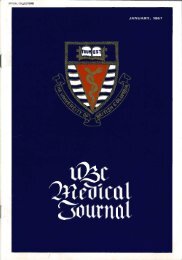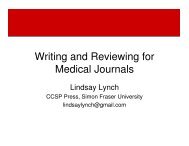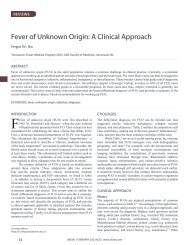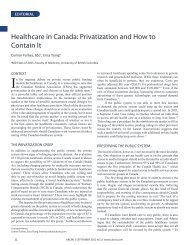Download article - UBC Medical Journal
Download article - UBC Medical Journal
Download article - UBC Medical Journal
You also want an ePaper? Increase the reach of your titles
YUMPU automatically turns print PDFs into web optimized ePapers that Google loves.
REVIEW<br />
Table 1. Steps Involved in the Use of Evidence-Based Medicine<br />
1. Defined and focused clinical question<br />
2. Thorough search of the appropriate literature for all relevant<br />
clinical trials<br />
3. Critical appraisal of the collected evidence<br />
4. Patient-centred decision making<br />
5. Monitoring of clinical outcomes<br />
EBM in Practice<br />
One of the central, but arguably most challenging, aspects of<br />
modern medicine is keeping informed of the latest research.<br />
In order to assist physicians with this task, systematic reviews<br />
have become an important component of the practice of EBM.<br />
A systematic review is the process whereby all available clinical<br />
trials that seek to answer a clinical question and meet predefined<br />
inclusion criteria are aggregated into an analysis in order to create an<br />
overall conclusion. Once a systematic review has been performed,<br />
updates with new relevant research are expected. Some groups,<br />
such as the Cochrane<br />
“<br />
C o l l a b o r a t i o n ,<br />
require such updates<br />
be performed at least<br />
every two years.<br />
These reviews are<br />
especially useful to<br />
practicing clinicians<br />
as they are designed<br />
to provide a<br />
summary of the<br />
Many medical<br />
schools are moving<br />
away from teaching<br />
methods of critical<br />
appraisal...and instead<br />
simply emphasizing<br />
the implementation of<br />
evidence.<br />
relevant clinical<br />
points that can be<br />
applied in medical<br />
practice.<br />
There are several independent organizations around the world<br />
that are involved in producing systematic reviews. The largest<br />
and most comprehensive is the Cochrane Collaboration, which<br />
was founded in 1992 and named in honour of Archie Cochrane,<br />
a pioneer in the use of randomized controlled trials. 8 It is a nonprofit<br />
organization with centers distributed internationally. At<br />
each centre, experts in EBM produce systematic reviews that<br />
appraise and summarize evidence from many trials on a particular<br />
topic. This type of evidence arguably ranks the highest because it<br />
critically appraises and interprets the evidence and then provides<br />
both the clinical implications and future research directions.<br />
Another major organization involved in producing evidencebased<br />
reports is the Therapeutics Initiative (TI), which was<br />
established in 1994 in the Department of Pharmacology and<br />
Therapeutics at the University of British Columbia. 9 The<br />
TI addresses controversial topics in medicine through short<br />
“Therapeutic Letters”, which are published every two months.<br />
The goal of these letters is to provide evidence-based prescription<br />
drug therapy after an extensive review of the most current<br />
literature by the Drug Assessment Working Group of the TI.<br />
Before the letters are published, drafts are reviewed by all the<br />
members of the TI, including experts in a particular therapeutic<br />
area. As a member of the International Society of Drug Bulletins<br />
and of the Cochrane Collaboration, the TI has both international<br />
and local impact through the dissemination of its Therapeutic<br />
Letters and other evidence-based reports on its website.<br />
As an example, in letter 62, the TI provides a case scenario<br />
to investigate the benefit gained from treating a patient with mild<br />
hypertension, defined as a blood pressure (BP) in the range of<br />
140-160/90-100 mmHg. 10 They conducted a best-evidence search<br />
and concluded that treating patients within this BP range for<br />
five years achieves, on average, a 0.8% absolute risk reduction<br />
for total cardiovascular events. These results indicate that 125<br />
patients must be treated with anti-hypertensive medications<br />
for five years in order to prevent one heart attack or stroke; in<br />
other words, the number needed to treat (NNT) would be 125<br />
patients for five years. In addition, no significant reduction in<br />
total mortality was demonstrated. Should the patient therefore be<br />
treated It is important that the patient understands the probability<br />
of benefit and participates in the decisions regarding treatment.<br />
This scenario demonstrates the complexity and difficulty of using<br />
EBM in practice. The fundamental message is that even the best<br />
evidence should not be blindly applied based on well-memorized<br />
cut-offs without placing the patient in context.<br />
EBM in the <strong>Medical</strong> Curriculum<br />
Careful practice of EBM by physicians and residents can help<br />
improve patient outcomes in the clinical setting, but will the use of<br />
EBM in teaching help medical students become better clinicians<br />
Over the past decade, EBM has become increasingly integrated<br />
into the curricula of many medical schools. This change has been<br />
shown to improve students’ ability to develop clinical questions<br />
and perform effective literature searches. 11 Evaluation of a<br />
longitudinal EBM curriculum has also shown an association with<br />
an increased breadth of knowledge of EBM that was sustained<br />
throughout the entire curriculum. 12 However, much work remains<br />
to be done in developing an effective curriculum for teaching<br />
EBM. One study evaluated perceived competence and actual<br />
performance in EBM techniques among medical graduates and<br />
found that, although many felt competent, the average score of the<br />
students was only 55% correct. 13<br />
In shaping their EBM curricula, many medical schools are<br />
moving away from teaching methods of critical appraisal, which<br />
form the basis of EBM, and instead simply emphasizing the<br />
implementation of evidence. 14 It is crucial that critical appraisal<br />
Table 2. Levels of Evidence by Study Design<br />
Level<br />
Ia<br />
Ib<br />
IIa<br />
IIb<br />
III<br />
IV<br />
Investigation Design<br />
Meta-analysis of many RCTs<br />
At least one large RCT<br />
One controlled trial, without randomization<br />
Controlled cohort or case-control studies<br />
Non-experimental observational studies<br />
Case reports and clinical opinions<br />
<strong>UBC</strong>MJ | SEPTEMBER 2009 1(1) | www.ubcmj.com 17










